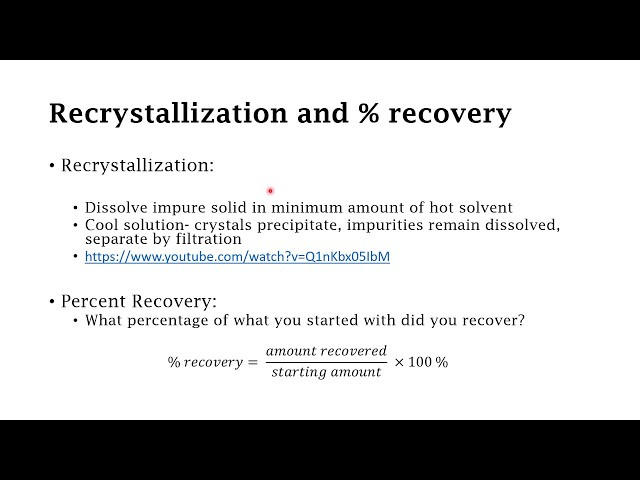In the realm of chemistry, the concept of percent recovery is crucial when assessing the efficiency and success of a laboratory procedure. It is a measure that indicates how much of a substance is recouped after a chemical reaction or physical separation has taken place compared to the initial amount. Understanding percent recovery is not only essential for scientists and students to evaluate their experiments, but it also has practical implications in industries that rely on chemical processes. With the intent to demystify this concept, we will explore accessible methods to calculate percent recovery, ensuring you can reliably evaluate your chemical processes’ effectiveness.

Understanding Percent Recovery
Before delving into calculations, it’s essential to have a clear grasp of what percent recovery means in a chemical context. Percent recovery refers to the proportion of material recovered from a process compared to the amount originally used. It is a tangible way to measure the efficiency of a reaction or purification.
Detailed Steps:
- Start with noting the initial amount of the substance before the process begins. This is your starting point for all subsequent calculations.
- After completing the chemical process, such as a reaction or purification step, measure the amount of substance that you have recovered.
- Use the formula for percent recovery, which is
(Amount of Substance Recovered / Initial Amount of Substance) x 100%. - Insert the measured values into the formula to calculate the percent recovery.
Summary:
The benefits of understanding percent recovery include the ability to optimize processes, conserve resources, and gauge purity of the product. A potential downside is that an inaccurate measurement at any point can lead to misleading percent recovery values.
Sample Collection and Preparation
The accuracy of percent recovery calculation starts with the correct sampling and preparation of your chemical. Ensuring that your sample is representative and properly prepared is paramount.
Detailed Steps:
- Collect a representative sample of the substance you’re working with, taking care to avoid contamination or loss.
- Prepare the sample as required by your experimental protocol, which may include drying, grinding, or homogenizing.
- Document the mass of the initial sample before any processing occurs.
Summary:
The benefit of careful sample collection and preparation is the assurance of consistent and accurate calculations. However, it may sometimes be time-consuming or require specialized equipment.
Accurate Measuring Techniques
Accuracy in measurement is crucial for calculating percent recovery, as errors can lead to significant deviations in the calculated value.
Detailed Steps:
- When measuring the initial and final amounts, use calibrated scales that provide precise readings.
- If dealing with liquids, employ volumetric equipment like pipettes or burettes that have been calibrated.
- Always record measurements to the correct significant figures.
Summary:
Precise measurements help ensure the reliability of your percent recovery calculations. They require meticulous attention to detail and sometimes more sophisticated equipment than what is found in basic laboratories.
The Role of Purity
Purity of the recovered substance can affect the percent recovery calculation, as impurities can inflate the perceived amount of recovered material.
Detailed Steps:
- If necessary, perform purification steps on your recovered substance to isolate the chemical of interest.
- Determine the level of impurities present in the recovered substance if they significantly impact your results.
- Account for the purity in your calculations by adjusting the quantity of recovered material to reflect only the pure substance.
Summary:
Considering purity in your calculations can lead to more accurate and meaningful percent recovery data. This, however, can make the process more complex and may require additional analytical techniques.
Impact of Losses
Understanding potential losses during the chemical process is crucial because they directly affect the percent recovery.
Detailed Steps:
- Identify all steps in your process where loss of material might occur, such as during transfer or in reactions with incomplete yields.
- Try to quantify the losses at each stage if possible.
- Adjust your calculations to reflect these potential losses.
Summary:
Recognizing and quantifying losses can make your percent recovery calculation more accurate. The downside is that it can be difficult to measure these losses precisely, and they may not always be avoidable.
Repeat Trials for Consistency
To ensure reliability, carrying out repeat experiments and calculating the percent recovery for each can provide a more accurate representation.
Detailed Steps:
- Repeat the experimental procedure multiple times, ensuring that the conditions are as identical as possible.
- Calculate the percent recovery for each trial.
- Take the average of these values for a more accurate overall percent recovery.
Summary:
Repeat trials increase confidence in the results. However, this requires additional time and resources.
Temperature and Pressure Considerations
Changes in temperature and pressure can affect the physical state and, consequently, the recovery of materials. It’s important to control or account for these factors during your processes.
Detailed Steps:
- Monitor and maintain temperature and pressure at required levels throughout your process.
- Consider the effect of any variations on the recovery of your substance and document any fluctuations.
Summary:
Controlling environmental factors eliminates variables that could alter recovery rates. This can sometimes necessitate sophisticated equipment and monitoring systems.
Use of Recovery Standards
Using recovery standards or internal standards can provide a benchmark to gauge percent recovery more accurately.
Detailed Steps:
- Select a recovery standard that behaves similarly to your substance during the entire process.
- Add a known quantity of this standard to your initial sample.
- Measure how much of this standard is recovered alongside your substance and use it to inform your calculations.
Summary:
Recovery standards can help correct for losses and improve accuracy. The challenge lies in selecting the appropriate standard and ensuring it does not interfere with the process.
Documentation and Record-Keeping
Thorough documentation can be an invaluable tool for tracking potential sources of error and variability in recovery calculations.
Detailed Steps:
- Keep detailed records of every step in your process, including weights, volumes, times, and environmental conditions.
- Use these records to identify variability or potential errors in your procedure affecting the recovery rate.
Summary:
Good record-keeping practices can uncover inconsistencies and lead to overall improved accuracy, but they require diligence and consistency.
Advanced Analytical Techniques
Using advanced analytical techniques such as chromatography or spectroscopy can aid in quantifying recovery with high precision.
Detailed Steps:
- Choose an analytical method appropriate for your substance.
- Calibrate the instruments using known standards.
- Use these techniques to accurately measure the quantity of recovered material.
Summary:
Advanced techniques can provide precise and accurate recovery data but often involve costly equipment and specialized knowledge.
Conclusion
Calculating percent recovery is a foundational skill in chemistry, playing a critical role in the assessment of a chemical process’s efficiency. By following the methodologies and embracing the tips and tricks provided, one can ensure greater accuracy and reliability in their findings, promoting a deeper understanding of the procedures at hand. While the process can sometimes seem complex, through practice and meticulous execution, the art of percent recovery becomes an invaluable asset in the chemist’s toolkit.
FAQs
Q1: What is percent recovery?
A1: Percent recovery is the percentage of a substance recovered from a chemical process compared to the amount originally used, reflecting the efficiency of the process.
Q2: Why is it important to calculate percent recovery?
A2: Calculating percent recovery helps evaluate the success and efficiency of a chemical procedure, influences the optimization of processes, and can determine the purity of the recovered material.
Q3: How can I ensure I get an accurate percent recovery calculation?
A3: To ensure accuracy, use precise measuring techniques, account for potential losses, control environmental conditions, carry out repeat trials, consider the purity of your recovered substance, and maintain thorough documentation throughout the process.









